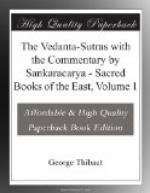The fourth pada of the first adhyaya has to be taken by itself. It is directed specially and avowedly against Sa@nkhya-interpretations of Scripture, not only in its earlier part which discusses isolated passages, but also—as is brought out much more clearly in the Sri-bhashya than by Sa@nkara—in its latter part which takes a general survey of the entire scriptural evidence for Brahman being the material as well as the operative cause of the world.
Deussen (p. 221) thinks that the selection made by the Sutrakara of Vedic passages setting forth the nature of Brahman is not in all cases an altogether happy one. But this reproach rests on the assumption that the passages referred to in the first adhyaya were chosen for the purpose of throwing light on what Brahman is, and this assumption can hardly be upheld. The Vedanta-sutras as well as the Purva Mima/m/sa-sutras are throughout Mima/m/sa i.e. critical discussions of such scriptural passages as on a prima facie view admit of different interpretations and therefore necessitate a careful enquiry into their meaning. Here and there we meet with Sutras which do not directly involve a discussion of the sense of some particular Vedic passage, but rather make a mere statement on some important point. But those cases are rare, and it would be altogether contrary to the general spirit of the Sutras to assume that a whole adhyaya should be devoted to the task of showing what Brahman is. The latter point is sufficiently determined in the first five (or six) adhikara/n/as; but after we once know what Brahman is we are at once confronted by a number of Upanishad passages concerning which it is doubtful whether they refer to Brahman or not. With their discussion all the remaining adhikara/n/as of the first adhyaya are occupied. That the Vedanta-sutras view it as a particularly important task to controvert the doctrine of the Sa@nkhyas is patent (and has also been fully pointed out by Deussen, p. 23). The fifth adhikara/n/a already declares itself against the doctrine that the world has sprung from a non-intelligent principle, the pradhana, and the fourth pada of the first adhyaya returns to an express polemic against Sa@nkhya interpretations of certain Vedic statements. It is therefore perhaps not saying too much if we maintain that the entire first adhyaya is due to the wish, on the part of the Sutrakara, to guard his own doctrine against Sa@nkhya attacks. Whatever the attitude of the other so-called orthodox systems may be towards the Veda, the Sa@nkhya system is the only one whose adherents were anxious—and actually attempted—to prove that their views are warranted by scriptural passages. The Sa@nkhya tendency thus would be to show that all those Vedic texts which the Vedantin claims as teaching the existence of Brahman, the intelligent and sole cause of the world, refer either to the pradhana or some product of the pradhana, or else to the purusha in the Sankhya




